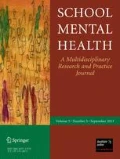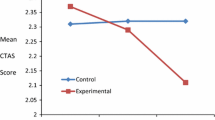Abstract
This paper (a) discusses the need for anxiety-focused prevention and intervention efforts, (b) discusses test anxiety interventions as an avenue toward building school partnerships to conduct anxiety-focused prevention and intervention efforts, and (c) provides a brief description of the University of New Orleans test anxiety program model and previously published findings. This paper also presents new data in support of our rationale from one of our screening assessments to highlight the linkages between test anxiety and anxiety problems more broadly and presents a brief summary of initial acceptability data. Data indicate that test anxiety was related to symptoms of anxiety disorders and depression. Moreover, among an initial wave of (n = 59) participants in a new intervention study, acceptability data are promising. For example, 96% indicating they were glad they participated and 70% of students showed substantial knowledge (at least 80% correct) of intervention content. Results are discussed in terms of how the data provide evidence for the importance of targeting test anxiety, future research directions, and applied implications.

Similar content being viewed by others
Notes
It is important to note that we do not believe that the test anxiety intervention discussed here should be a first-line intervention for severe anxiety disorders such as PTSD in youth. Intensive multimodal CBT interventions are the most promising in this regard (e.g., see Feeney, Treadwell, Foa, & March, 2004; La Greca & Silverman, 2006). Our goal was to help students excel in school by trying to reduce test anxiety among youth already dealing with much stress and anxiety. Students with severe problems were referred for further evaluation and treatment (see Fig. 1). The point is that the intervention may be used in difficult circumstances and among high risk groups, not that it should be used to treat severe distress.
References
Albano, A. M., & Kendall, P. C. (2002). Cognitive behavioural therapy for children and adolescents with anxiety disorders: clinical research advances. International Review of Psychiatry, 14, 129–134.
American Psychiatric Association. (1994). Diagnostic and statistical manual of mental disorders (DSM-IV) (4th ed.). Washington, DC: American Psychiatric Association.
Bandura, A. (1982). Self-efficacy mechanism in human agency. American Psychologist, 37, 122–147.
Barlow, D. H. (2004). Psychological treatments. American Psychologist, 59, 869–878.
Barrett, P. M., & Turner, C. (2001). Prevention of anxiety symptoms in primary school children: preliminary results from a universal school-based trial. British Journal of Clinical Psychology, 40, 399–410.
Beidel, D. C., & Turner, S. M. (1988). Comorbidity of test anxiety and other anxiety disorders in children. Journal of Abnormal Child Psychology, 16, 275–287.
Beidel, D. C., Turner, S. M., & Trager, K. N. (1994). Test anxiety and childhood anxiety disorders in African American and White school children. Journal of Anxiety Disorders, 8, 169–179.
Carter, R., Williams, S., & Silverman, W. K. (2008). Cognitive and emotional facets of test anxiety in African American school children. Cognition and Emotion, 22, 539–551.
Chavira, D. A., Stein, M. B., Bailey, K., & Stein, M. T. (2003). Parental opinions regarding treatment for Social Anxiety Disorder in youth. Journal of Developmental and Behavioral Pediatrics, 24, 315–322.
Cheek, J. R., Bradley, L. J., Reynolds, J., & Coy, D. (2002). An intervention for helping elementary students reduce test anxiety. Professional School Counseling, 6, 162–164.
Chorpita, B. F., Yim, L., Moffitt, C., Umemoto, L. A., & Francis, S. E. (2000). Assessment of symptoms of DSM-IV anxiety and depression in children: A revised child anxiety and depression scale. Behaviour Research and Therapy, 38, 835–855.
Dadds, M. R., Holland, D. E., Laurens, K. R., Mullins, M., Barrett, P. M., & Spence, S. H. (1999). Early intervention and prevention of anxiety disorders in children: Results at two year follow-up. Journal of Consulting and Clinical Psychology, 67, 145–150.
Ergene, T. (2003). Effective interventions on test anxiety reduction: A meta-analysis. School Psychology International, 24, 313–328.
Feeney, N. C., Treadwell, K. R., Foa, E. B., & March, J. (2004). Posttraumatic stress disorder in youth: A critical review of the cognitive and behavioral treatment outcome literature. Professional Psychology: Research and Practice, 35, 466–476.
Fox, J., Halpern, L., & Forsyth, J. (2008). Mental health checkups for children and adolescents: A means to identify, prevent, and minimize suffering associated with anxiety and mood disorders. Clinical Psychology: Science and Practice, 15, 182–211.
Frederick, C. J., Pynoos, R. S., & Nadar, K. (1992). Reaction index to psychic trauma form C (Child). Los Angeles: University of California.
Hembree, R. (1988). Correlates, causes, effects, and treatment of test anxiety. Review of Educational Research, 58, 47–77.
Hensley, L., & Varela, R. E. (2008). PTSD symptoms and somatic complaints following Hurricane Katrina: The role of trait anxiety and anxiety sensitivity. Journal of Clinical Child and Adolescent Psychology, 37, 542–552.
Kendall, P. C. (1994). Treating anxiety disorders in children: Results of a randomized clinical trial. Journal of Consulting and Clinical Psychology, 62, 200–210.
Kendall, P. C., Safford, S., Flannery-Schroeder, E., & Webb, A. (2004). Child anxiety treatment: Outcomes in adolescence and impact on substance use and depression at 7.4-year follow-up. Journal of Consulting and Clinical Psychology, 72, 276–287.
King, N. J., Mietz, A., Tinney, L., & Ollendick, T. H. (1995). Psychopathology and cognition in adolescents experiencing severe test anxiety. Journal of Clinical Child Psychology, 24, 49–54.
La Greca, A. M., & Silverman, W. K. (2006). Children and disasters and terrorism. In P. C. Kendall (Ed.), Child and adolescent therapy: Cognitive-behavioral procedures (3rd ed., pp. 356–382). New York: Guilford Press.
La Greca, A. M., Silverman, W. K., Vernberg, E. M., & Prinstein, M. (1996). Symptoms of posttraumatic stress after Hurricane Andrew: A prospective study. Journal of Consulting and Clinical Psychology, 64, 712–723.
Ludlow, L. H., & Guida, F. V. (1991). The test anxiety scale for children as a generalized measure of academic anxiety. Educational and Psychological Measurement, 51, 1013–1021.
McDonald, A. S. (2001). The prevalence and effects of test anxiety in school children. Educational Psychology, 21, 89–101.
Mojtabai, R., & Olfson, M. (2006). Treatment seeking for depression in Canada and the United States. Psychiatric Services, 57, 631–639.
Moses, E. B., & Barlow, D. H. (2006). A new unified treatment approach for emotional disorders based on emotion science. Current Directions in Psychological Science, 15, 146–150.
No Child Left Behind Act of (2002). Public Law 107–110, January 8, 2002, 115 STAT 1425. Available on the web at http://www.ed.gov/policy/elsec/leg/esea02/107-110.pdf.
Prins, P. J., Groot, M. J., & Hanewald, G. J. (1994). Cognition in test-anxious children: The role of on-task and coping cognition reconsidered. Journal of Consulting and Clinical Psychology, 62, 404–409.
Rabalais, A. E., Ruggiero, K. J., & Scotti, J. R. (2002). Multicultural issues in the response of children to disasters. In A. M. La Greca, W. K. Silverman, E. M. Vernberg, & M. C. Roberts (Eds.), Helping children cope with disasters and terrorism (pp. 73–99). Washington, DC: American Psychological Association.
Sarason, S. B., Davidson, K., Lighthall, F., & Waite, R. (1958). A test anxiety scale for children. Child Development, 29, 105–113.
Silverman, W. K., Kurtines, W. M., Ginsburg, G. S., Weems, C. F., Lumpkin, P. W., & Carmichael, D. H. (1999). Treating anxiety disorders in children with group cognitive-behavioral therapy: A randomized clinical trial. Journal of Consulting and Clinical Psychology, 67, 995–1003.
Silverman, W. K., Pina, A. A., & Viswesvaran, C. (2008). Evidence-based psychosocial treatments for phobic and anxiety disorders in children and adolescents. Journal of Clinical Child & Adolescent Psychology, 37, 105–130.
Spence, S. H. (1997). Structure of anxiety symptoms among children: A confirmatory factor-analytic study. Journal of Abnormal Psychology, 106, 280–297.
Tabachnick, G., & Fidell, L. S. (2001). Using multivariate statistics (4th ed.). Boston: Allyn & Bacon.
Vernberg, E. M., La Greca, A. M., Silverman, W. K., & Prinstein, M. (1996). Predictors of children’s post-disaster functioning following Hurricane Andrew. Journal of Abnormal Psychology, 105, 237–248.
Weems, C. F. (1999). Psychological inquiry and the role of world views. Behavior and Philosophy, 27, 147–163.
Weems, C. F. (2005). Comprehensive school based test anxiety and related problems screening and intervention program. New Orleans, LA: University of New Orleans.
Weems, C. F. (2008a). Making the need salient and the benefits clear: A commentary on anxiety and depression focused mental health checkups for children and adolescents. Clinical Psychology: Science and Practice, 15, 212–216.
Weems, C. F. (2008b). Developmental trajectories of childhood anxiety: Identifying continuity and change in anxious emotion. Developmental Review, 28, 488–502.
Weems, C. F., & Costa, N. M. (2005). Developmental differences in the expression of childhood anxiety symptoms and fears. Journal of the American Academy of Child and Adolescent Psychiatry, 44, 656–663.
Weems, C. F., Piña, A. A., Costa, N. M., Watts, S. E., Taylor, L. K., & Cannon, M. F. (2007). Pre-disaster trait anxiety and negative affect predict posttraumatic stress in youth after Hurricane Katrina. Journal of Consulting and Clinical Psychology, 75, 154–159.
Weems, C. F., Taylor, L. K., Cannon, M. F., Marino, R., Romano, D. M., Scott, B. G., et al. (2010). Post traumatic stress, context, and the lingering effects of the Hurricane Katrina disaster among ethnic minority youth. Journal of Abnormal Child Psychology, 38, 49–56.
Weems, C. F., Taylor, L. K., Costa, N. M., Marks, A. B., Romano, D. M., Verrett, S. L., et al. (2009). Effect of a school-based test anxiety intervention in ethnic minority youth exposed to Hurricane Katrina. Journal of Applied Developmental Psychology, 30, 218–226.
Weems, C. F., Zakem, A., Costa, N. M., Cannon, M. F., & Watts, S. E. (2005). Physiological response and childhood anxiety: Association with symptoms of anxiety disorders and cognitive bias. Journal of Clinical Child and Adolescent Psychology, 34, 712–723.
Acknowledgments
This research discussed in this article was made possible by grants from the National Institute of Mental Health (MH067572), UNO Investing in Research Excellence, and Institute of Mental Hygiene to Carl Weems. The author would like to acknowledge Reshelle C. Marino, Shannon L. Verrett, & Darlene M. Brown for their collaboration on the projects discussed.
Author information
Authors and Affiliations
Corresponding author
Rights and permissions
About this article
Cite this article
Weems, C.F., Scott, B.G., Taylor, L.K. et al. Test Anxiety Prevention and Intervention Programs in Schools: Program Development and Rationale. School Mental Health 2, 62–71 (2010). https://doi.org/10.1007/s12310-010-9032-7
Published:
Issue Date:
DOI: https://doi.org/10.1007/s12310-010-9032-7




